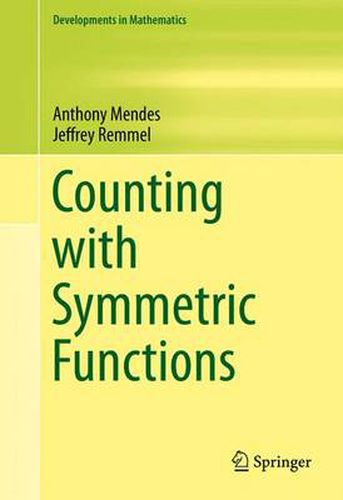Readings Newsletter
Become a Readings Member to make your shopping experience even easier.
Sign in or sign up for free!
You’re not far away from qualifying for FREE standard shipping within Australia
You’ve qualified for FREE standard shipping within Australia
The cart is loading…






This title is printed to order. This book may have been self-published. If so, we cannot guarantee the quality of the content. In the main most books will have gone through the editing process however some may not. We therefore suggest that you be aware of this before ordering this book. If in doubt check either the author or publisher’s details as we are unable to accept any returns unless they are faulty. Please contact us if you have any questions.
This monograph provides a self-contained introduction to symmetric functions and their use in enumerative combinatorics. It is the first book to explore many of the methods and results that the authors present. Numerous exercises are included throughout, along with full solutions, to illustrate concepts and also highlight many interesting mathematical ideas.
The text begins by introducing fundamental combinatorial objects such as permutations and integer partitions, as well as generating functions. Symmetric functions are considered in the next chapter, with a unique emphasis on the combinatorics of the transition matrices between bases of symmetric functions. Chapter 3 uses this introductory material to describe how to find an assortment of generating functions for permutation statistics, and then these techniques are extended to find generating functions for a variety of objects in Chapter 4. The next two chapters present the Robinson-Schensted-Knuth algorithm and a method for proving Polya’s enumeration theorem using symmetric functions. Chapters 7 and 8 are more specialized than the preceding ones, covering consecutive pattern matches in permutations, words, cycles, and alternating permutations and introducing the reciprocity method as a way to define ring homomorphisms with desirable properties.
Counting with Symmetric Functions will appeal to graduate students and researchers in mathematics or related subjects who are interested in counting methods, generating functions, or symmetric functions. The unique approach taken and results and exercises explored by the authors make it an important contribution to the mathematical literature.
$9.00 standard shipping within Australia
FREE standard shipping within Australia for orders over $100.00
Express & International shipping calculated at checkout
This title is printed to order. This book may have been self-published. If so, we cannot guarantee the quality of the content. In the main most books will have gone through the editing process however some may not. We therefore suggest that you be aware of this before ordering this book. If in doubt check either the author or publisher’s details as we are unable to accept any returns unless they are faulty. Please contact us if you have any questions.
This monograph provides a self-contained introduction to symmetric functions and their use in enumerative combinatorics. It is the first book to explore many of the methods and results that the authors present. Numerous exercises are included throughout, along with full solutions, to illustrate concepts and also highlight many interesting mathematical ideas.
The text begins by introducing fundamental combinatorial objects such as permutations and integer partitions, as well as generating functions. Symmetric functions are considered in the next chapter, with a unique emphasis on the combinatorics of the transition matrices between bases of symmetric functions. Chapter 3 uses this introductory material to describe how to find an assortment of generating functions for permutation statistics, and then these techniques are extended to find generating functions for a variety of objects in Chapter 4. The next two chapters present the Robinson-Schensted-Knuth algorithm and a method for proving Polya’s enumeration theorem using symmetric functions. Chapters 7 and 8 are more specialized than the preceding ones, covering consecutive pattern matches in permutations, words, cycles, and alternating permutations and introducing the reciprocity method as a way to define ring homomorphisms with desirable properties.
Counting with Symmetric Functions will appeal to graduate students and researchers in mathematics or related subjects who are interested in counting methods, generating functions, or symmetric functions. The unique approach taken and results and exercises explored by the authors make it an important contribution to the mathematical literature.